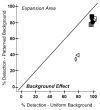Peripheral prism glasses: effects of dominance, suppression, and background
- PMID: 22885783
- PMCID: PMC3429711
- DOI: 10.1097/OPX.0b013e3182678d99
Peripheral prism glasses: effects of dominance, suppression, and background
Abstract
Purpose: Unilateral peripheral prisms for homonymous hemianopia (HH) place different images on corresponding peripheral retinal points, a rivalrous situation in which local suppression of the prism image could occur and thus limit device functionality. Detection with peripheral prisms has primarily been evaluated using conventional perimetry, where binocular rivalry is unlikely to occur. We quantified detection over more visually complex backgrounds and examined the effects of ocular dominance.
Methods: Detection rates of eight participants with HH or quadranopia and normal binocularity wearing unilateral peripheral prism glasses were determined for static perimetry targets briefly presented in the prism expansion area (in the blind hemifield) and the seeing hemifield, under monocular and binocular viewing, over uniform gray and more complex patterned backgrounds.
Results: Participants with normal binocularity had mixed sensory ocular dominance, demonstrated no difference in detection rates when prisms were fitted on the side of the HH or the opposite side (p > 0.2), and had detection rates in the expansion area that were not different for monocular and binocular viewing over both backgrounds (p > 0.4). However, two participants with abnormal binocularity and strong ocular dominance demonstrated reduced detection in the expansion area when prisms were fitted in front of the non-dominant eye.
Conclusions: We found little evidence of local suppression of the peripheral prism image for HH patients with normal binocularity. However, in cases of strong ocular dominance, consideration should be given to fitting prisms before the dominant eye. Although these results are promising, further testing in more realistic conditions including image motion is needed.
Figures
















Similar articles
-
Peripheral prism glasses: effects of moving and stationary backgrounds.Optom Vis Sci. 2015 Apr;92(4):412-20. doi: 10.1097/OPX.0000000000000552. Optom Vis Sci. 2015. PMID: 25785533 Free PMC article.
-
Binocular rivalry with peripheral prisms used for hemianopia rehabilitation.Ophthalmic Physiol Opt. 2014 Sep;34(5):573-9. doi: 10.1111/opo.12143. Ophthalmic Physiol Opt. 2014. PMID: 25160892
-
No Useful Field Expansion with Full-field Prisms.Optom Vis Sci. 2018 Sep;95(9):805-813. doi: 10.1097/OPX.0000000000001271. Optom Vis Sci. 2018. PMID: 30169356 Free PMC article.
-
Patients with homonymous hemianopia become visually qualified to drive using novel monocular sector prisms.J Neuroophthalmol. 2014 Mar;34(1):53-6. doi: 10.1097/WNO.0000000000000060. J Neuroophthalmol. 2014. PMID: 24135970
-
Randomized crossover clinical trial of real and sham peripheral prism glasses for hemianopia.JAMA Ophthalmol. 2014 Feb;132(2):214-22. doi: 10.1001/jamaophthalmol.2013.5636. JAMA Ophthalmol. 2014. PMID: 24201760 Free PMC article. Clinical Trial.
Cited by
-
Psychophysical Tests Do Not Identify Ocular Dominance Consistently.Iperception. 2019 Apr 29;10(2):2041669519841397. doi: 10.1177/2041669519841397. eCollection 2019 Mar-Apr. Iperception. 2019. PMID: 31069044 Free PMC article.
-
Vision concerns after mild traumatic brain injury.Curr Treat Options Neurol. 2015 Feb;17(2):329. doi: 10.1007/s11940-014-0329-y. Curr Treat Options Neurol. 2015. PMID: 25619534
-
Driving With Hemianopia VI: Peripheral Prisms and Perceptual-Motor Training Improve Detection in a Driving Simulator.Transl Vis Sci Technol. 2018 Jan 18;7(1):5. doi: 10.1167/tvst.7.1.5. eCollection 2018 Jan. Transl Vis Sci Technol. 2018. PMID: 29359111 Free PMC article.
-
The effect of visual rivalry in peripheral head-mounted displays on mobility.Sci Rep. 2023 Nov 18;13(1):20199. doi: 10.1038/s41598-023-47427-8. Sci Rep. 2023. PMID: 37980436 Free PMC article.
-
Monovision Correction Preference and Eye Dominance Measurements.Transl Vis Sci Technol. 2023 Mar 1;12(3):18. doi: 10.1167/tvst.12.3.18. Transl Vis Sci Technol. 2023. PMID: 36939712 Free PMC article.
References
-
- Gilhotra JS, Mitchell P, Healey PR, Cumming RG, Currie J. Homonymous visual field defects and stroke in an older population. Stroke. 2002;33:2417–20. - PubMed
-
- Zhang X, Kedar S, Lynn MJ, Newman NJ, Biousse V. Homonymous hemianopias: clinical-anatomic correlations in 904 cases. Neurology. 2006;66:906–10. - PubMed
-
- Peli E, Peli D. Driving With Confidence: A Practical Guide to Driving With Low Vision. Singapore: World Scientific; 2002.
-
- O’Neil EC, Connell PP, O’Connor JC, Brady J, Reid I, Logan P. Prism Therapy and Visual Rehabilitation in Homonymous Visual Field Loss. Optom Vis Sci. 2011;88:263–8. - PubMed
Publication types
MeSH terms
Grants and funding
LinkOut - more resources
Full Text Sources
Medical

